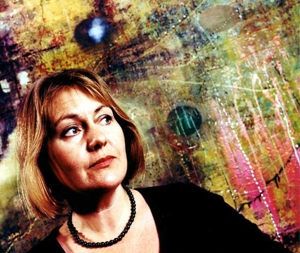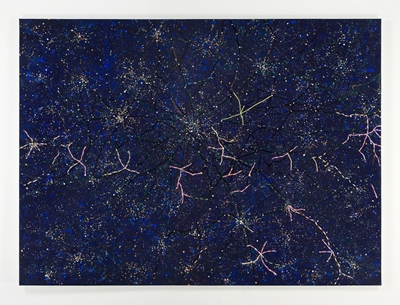All GAM 2012 Programs
21-22 April 2012
Canadian Artist, Landon Mackenzie Resonates a Never-Ending Sky – NEUROSTAR
Watch the video here: http://vimeo.com/38396403

The artwork series “Neurostar,” created by the leading Canadian artist Landon Mackenzie, will be showcased in a new video accessible from the GAM website on 21-22 April 2012. (See the GAM website on or after 21 April for the link.) An award-winning painter and avant-garde experimentalist in images, she is the recipient of numerous awards including the 2003 Queen Elizabeth Golden Jubilee Medal (for her outstanding contribution to art in Canada), as well as the inaugural Ian Wallace Excellence in Teaching Award for her work as a passionate educator.
Mackenzie has been based for the last twenty-five years in Vancouver, B.C., Canada, where she is a professor at Emily Carr University of Art + Design. Her paintings are characteristically large and intensely involved in the continuation of the discipline of painting.
Personal/Biographical Statement: My larger paintings, made over the past decade, involve my interest in the intersecting territories of cities, maps, waterways and dark space as nervous systems and the ongoing possibilities of using conventions of both landscape and abstraction to achieve my goals and create pictures (that also work well as paintings). Grouped together under titles such as The Structures or Neurocity, they are large and complex pieces charged for effectiveness as optical and corporal experiences. Signals and wiring, neurons, cells, balloons, circles and squares, electric tower scaffolding, lily pads, ladders, railway tracking and filmstrips are recognizable but all disconnected from regular function.
My larger paintings, made over the past decade, involve my interest in the intersecting territories of cities, maps, waterways and dark space as nervous systems and the ongoing possibilities of using conventions of both landscape and abstraction to achieve my goals and create pictures (that also work well as paintings). Grouped together under titles such as The Structures or Neurocity, they are large and complex pieces charged for effectiveness as optical and corporal experiences. Signals and wiring, neurons, cells, balloons, circles and squares, electric tower scaffolding, lily pads, ladders, railway tracking and filmstrips are recognizable but all disconnected from regular function.
I’ve always been interested in the nocturnal traditions of painting and the representation of the night sky. There are painters that have done a great job of this, including Turner’s paintings of the burning of London or the Canadian Prairie painter William Kurelek. Perhaps being Canadian has increased my attraction to paintings with dark night skies, given the long hours of darkness in the northern regions. Canadians have the saying about the Prairies as a “never-ending sky” and Vancouver (where I live now), with its clear skies due to the turbulent winds coming off the Pacific, is a city where the land and sky merge into a dramatic skyline. My summer studio is on the opposite side of the country, off of the Atlantic Ocean, in a remote part of Prince Edward Island that is far from city lights and where the study of the sky means lying out with the mosquitoes to watch falling comets or shooting stars merge. Now as I see the North Star, I find satellite and international airplane highways where plane after plane travels along a narrow path from Europe to the USA.  I grew up in the middle of the country and spent all my summers in a rural lake district we in Canada call the “Near North”, as opposed to the Far North. We were only a couple of hours north of my winter home in Toronto but in a kind of wilderness. I remember many nights as a child lying in the bottom of a small motorboat, while my parents brought us home to our own cottage from dances on an island. Lying on top of a pile of life jackets and looking up at a starlit August sky as the boat passed down the channel of dark water, I was in safe transport as a little girl. The drone of the boat’s engine reverberated against the wooden floorboards like an instrument and the cinematic movement of the sky and stars above is a wonderful memory.
I grew up in the middle of the country and spent all my summers in a rural lake district we in Canada call the “Near North”, as opposed to the Far North. We were only a couple of hours north of my winter home in Toronto but in a kind of wilderness. I remember many nights as a child lying in the bottom of a small motorboat, while my parents brought us home to our own cottage from dances on an island. Lying on top of a pile of life jackets and looking up at a starlit August sky as the boat passed down the channel of dark water, I was in safe transport as a little girl. The drone of the boat’s engine reverberated against the wooden floorboards like an instrument and the cinematic movement of the sky and stars above is a wonderful memory.  As a younger painter, I challenged myself to make paintings with a full moon, which has got to be the corniest of subject matter and hard to do without making it ridiculously sappy. In each of my bodies of work over the years I always include at least one dark night painting such as ‘Blue Night Voices’ from the Saskatchewan Paintings, which is in the National Gallery of Canada, or ‘Space Station’ from the Tracking Athabasca series in the Vancouver Art Gallery. Currently I am making a series called Neurostar, playing with fictitious star constructions, little neurological indicators and man-made fictitious phenomena in a nod to reports of space debris.
As a younger painter, I challenged myself to make paintings with a full moon, which has got to be the corniest of subject matter and hard to do without making it ridiculously sappy. In each of my bodies of work over the years I always include at least one dark night painting such as ‘Blue Night Voices’ from the Saskatchewan Paintings, which is in the National Gallery of Canada, or ‘Space Station’ from the Tracking Athabasca series in the Vancouver Art Gallery. Currently I am making a series called Neurostar, playing with fictitious star constructions, little neurological indicators and man-made fictitious phenomena in a nod to reports of space debris.
###







